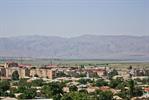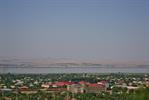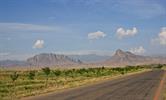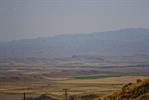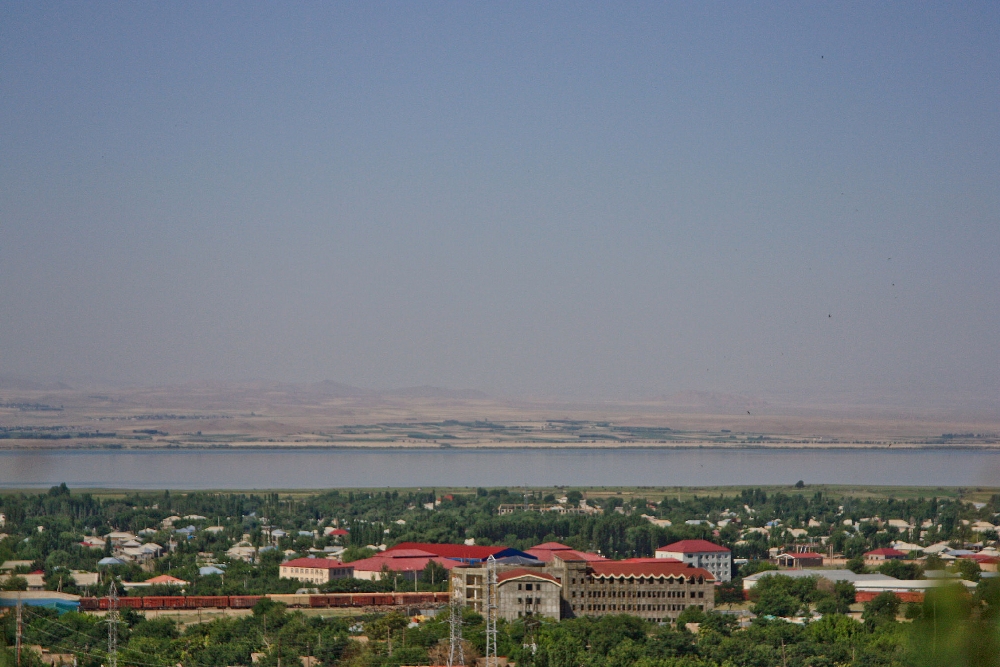 Naxchivan city, oddly enough the capital of the province, is likely the place any tourist will visit. It lies on a low plateau overlooking the Araz river, the natural border between Iran and Naxchivan. And on a super clear day, you might even be able to see Mt. Ararat in Eastern Turkey. Despite a rash of shiny new buildings on its long main streets, the atmosphere is one of sleepy torpor, as the incredible summer heat renders most activities beyond playing nard and drinking tea out of the question.
Naxchivan city, oddly enough the capital of the province, is likely the place any tourist will visit. It lies on a low plateau overlooking the Araz river, the natural border between Iran and Naxchivan. And on a super clear day, you might even be able to see Mt. Ararat in Eastern Turkey. Despite a rash of shiny new buildings on its long main streets, the atmosphere is one of sleepy torpor, as the incredible summer heat renders most activities beyond playing nard and drinking tea out of the question.
But the real highlights of the city are the scattering of monuments throughout town. Some dating back to almost 1,000 years ago. The most famous, and impressive, is Momina Xatun Mausoleum. It is easily the most recognizable Naxchivani landmark for the average Azerbaijani person. It is perhaps the finest single antique monument in Azerbaijan, although currently wrapped in scaffolding to counter a Pisa-style lean. It’s a glorious, gently leaning 26m brick tower decorated with geometric patterns and Kufic script (a stylised, angular form of Arabic) picked out in turquoise glaze.
Built in 1186 by Acami Abubakiroglu Nakhchivani, experts differ over exactly which royal lady it was intended to honour. Located in the park of the same name, the mausoleum dates from 1186 and entombs the founder of the Atabey dynasty, Shemseddin Eldeniz, along with his beloved wife, for whom the monument is named. The graves themselves were removed to St Petersburg during the 1950s, but the hollow interior features a small exhibition of relevant photos and drawings, including images of the minaret-gate and historic Cuma mosque that survived beside the mausoleum until the 19th century. The outside is adorned with beautiful patterns and engravings, many of which are in a turquoise glaze.
The real star remains the architect whose statue sits in a traffic island nearby. It was self-consciously designed to awe the observer with its soaring height and its Kufic script on the dome which apparently means 'we are temporal, the world is eternal, we shall die but the memory remains'.
Close to Momina Xatun is a paved, openair 'museum' of historic stone rams and grave markers plus a promenade offering views down over the lower town with Mt Ararat visible on an exceptionally clear day. The promenade culminates in a formal garden containing the Carpet Museum housed in the rebuilt palace of Ehsan Khan, Naxcivan's 18th century monarch. Despite the shabaka windows and attractive exterior porches, the building isn't quite as impressive as Sheki's equivalent. Nonetheless the rug displays are well chosen if you want to learn the difference between a kilim and a sumax or palaz, or to recognise the four main styles of Azeri carpet making. The ghoulish centrepiece is a totally non-ironic silk-wool carpet portrait of a young Heydar Aliyev, replete with Soviet medals. Two side rooms relate to the history of the Naxcivan khanate, replicate the khan's cushion-throne and gratuitously add photos of Yerevan (now the Armenian capital) to remind visitors that that was once a Turkic khanate too.
The red-brick Blue Mosque (Nizami kuc) isn't very blue at all but makes a useful landmark when approaching the Momina Xatun area by marshrutka.
Hidden in Naxchivan back streets are a couple of medieval pointed tomb-towers in an octagonal form common throughout eastern Anatolia. The best known is the 1162 Mausoleum of Yusif Huseynoglu (who was apparently some guy who did something), by the same architect as the Momina Xatun tower. It's a little hidden in the back streets, so the reward is just looking for it.
The khans who once ruled from the Carpet Museum were buried in a squat, rather overrestored brick tomb complex with a simple blue-glaze dome. Known simply as the Imamzade, it's below a graveyard on what were once the city's citadel walls. Access is from the road to the train station (marshrutka 2 from Nizami kuc).
There are a few museums and mosque here and there, but really nothing spectacular. Just on the outskirts of town, on the road to Turkey, there is a war memorial. It is really nicely set on a small hill, and has a well-manicured park which is great for watching some of Naxchivan's older citizens. Although you are certain to get more than your fair share of stares.
The town's biggest mosques are modern affairs. Built in pallid yellow brick the Hazrat Zohra mosque (Islam Safarli kuc) sports twin, rectilinear minarets and a metal-clad dome looking more like a lagged boiler tank. It's nicknamed the 'Iranian mosque', as it was funded by Naxcivan's southern neighbour. Not to be outdone, Turks stumped up money to build the impressive Kazim Karabakir Pasha Mosque behind the bazaar. This grandly domed stone edifice has elegant missile-style twin minarets and splendid gilt inscriptions on the white marble doorway. However, if you're coming from Turkey you're likely to have seen dozens of similar structures.
Another suggestion while in Naxichevan is to visit the salt mines located 10 km outside the city. This is actually an asthma centre drilled into the salt mountain. It is used for asthmatics as a natural cure - the clients then sleep inside the cave during the night. The smell of salt is very pervasive as soon as you get inside. There is a long path to the 'hotel' inside. You will definitely find it interesting. To enter the mountain, one needs to get approved by a doctor, but they generally don't mind. There is a newly build 5-star hotel just outside for the relatives of patients that spend nights inside salt mountain.
If you're planning a trip to Azerbaijan you may be interested ▶ Azerbaijan highlights - For those who prefer to go unbeaten path, to explore less visited places and check national charisma of this small country in Southern Caucasus on the edge of Europe.



